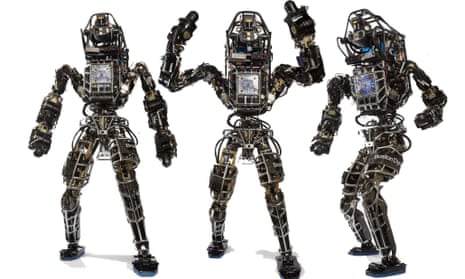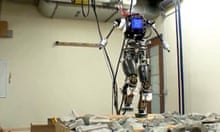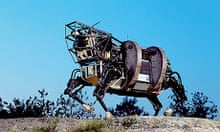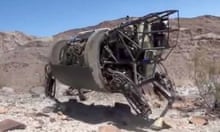Google’s recent acquisition of Boston Dynamics marks its eighth robotics purchase in the past six months, showing Google’s “moonshot” robotics vision is more than just a pet project.
Boston Dynamics is the most high-profile acquisition, however, instantly adding world-leading robotics capability, including robots that can walk all on their own, to Google’s arsenal – as well as significant links to the US military – conjuring images of Skynet and the artificial intelligence-led robot uprising straight out of the 1984 film The Terminator.
What is it?
Boston Dynamics is an engineering and robotics design company that works across a wide range of computer intelligence and simulation systems, as well as large, advanced robotic platforms.
The company was created as a technology spin-off from Massachusetts Institute of Technology by Prof Marc Raibert in 1992, then the founder and lead researcher of the Leg Lab – a research group focussed on systems that move dynamically, including legged robots.
What does it do?
Raibert describes the Boston Dynamics team as “simply engineers that build robots”, but in reality Boston Dynamics is much more than that.
Its robotics work is at the forefront of the technology creating the self-proclaimed “most advanced robots on Earth” particularly focused around self-balancing humanoid or bestial robots.
Funding for the majority of the most advanced Boston Dynamics robots comes from military sources, including the US Defence Advanced Research Projects Agency (Darpa) and the US army, navy and marine corps. The terms of contracts currently held by Boston Dynamics with military bodies are unknown, although Google has committed to honouring existing contracts, including recent $10.8m funding from Darpa.
BigDog
Funded by Darpa and the US army, BigDog is Boston Dynamics’ most famous robot, a large mule-like quadruped that walks around like a dog, self balancing and navigating a range of terrain.
Standing about 76cm tall, 91cm long and weighing 109kg, BigDog is an autonomous system powered by an engine and controlled by on-board computer system processing a series of sensors that monitor joint position, joint force, ground contact, ground load, a gyroscope, LIDAR and a stereo vision system.
BigDog is capable of running at 4mph, climbing 35 degree slopes and carrying 155kg loads. Its derivative, the Legged Squad Support Systems, increases BigDog's carrying capacity to 181kg with a 20-mile range.
Cheetah
The world’s fastest robot, Cheetah, runs like a big cat at over 29mph – faster than 100m world champion sprinter Usain Bolt. Like a real cheetah, the robot has an articulated back that flexes back and forth with each step, increasing its stride length and running speed.
Funded by Darpa's Maximum Mobility and Manipulation program, in its current implementation Cheetah runs tethered on a treadmill, powered by a separate hydraulic pump.
The next generation of the Cheetah platform designed to operate untethered, the WildCat, recently entered initial testing.
Atlas
One of Boston Dynamics’ latest robots funded by Darpa, Atlas is a humanoid robot designed to negotiate outdoor, rough terrain in a bipedal manner, while being able to climb using hands and feet as a human would.
Atlas is will be equipped with articulated hands with sensors enabling the robot to use tools designed for humans, as well as an articulated sensor head including stereo cameras and a laser range finder. The robot currently is powered by a tethered electric power supply, and controlled remotely.
Other robots in the Boston Dynamics stable include Petman, a robot that tests humanoid chemical protective clothing; the wheeled SandFlea robot that can leap small buildings; a small six-legged robot capable of traversing rough terrain called RHex; and the RiSE robot capable of climbing vertical walls, trees and fences using feet with micro-claws.
What else has Google got?
Boston Dynamics is not the only robotics company Google has bought in recent years. Put under the leadership of Andy Rubin, previously Google's head of Android, the search company has quietly acquired seven different technology companies to foster a self-described “moonshot” robotics vision.
The acquired companies included Schaft, a small Japanese humanoid robotics company; Meka and Redwood Robotics, San Francisco-based creators of humanoid robots and robot arms; Bot & Dolly who created the robotic camera systems recently used in the movie Gravity; Autofuss an advertising and design company; Holomni, high-tech wheel designer, and Industrial Perception, a startup developing computer vision systems for manufacturing and delivery processes.
Sources told the New York Times that Google’s initial plans are not consumer-focused, instead aimed at manufacturing and industry automation, although products are expected within the next three to five years.
Rubin, before making Android into a mobile powerhouse, started life as a robotics engineer at Zeiss. He has now convinced Google founders Sergey Brin and Larry Page to fund a commercial robotics venture, something Rubin has been mulling for some 10 years.
Robotic cars
Google is no stranger to robots. Its robotic car project, which kicked off in 2009, is one of the leaders in the field. It currently has a fleet of at least 10 converted Toyota Priuses, which have covered more than 300,000 miles on Californian roads without incident.
The robotic cars have roof-mounted cameras and sensors that monitor the road ahead and its surroundings, building a 3D model of the route and navigating obstacles.
In 2012, a blind man names Steve Mahan was allowed behind the wheel of a Google self-driving car in Morgan Hill, California.







Comments (…)
Sign in or create your Guardian account to join the discussion